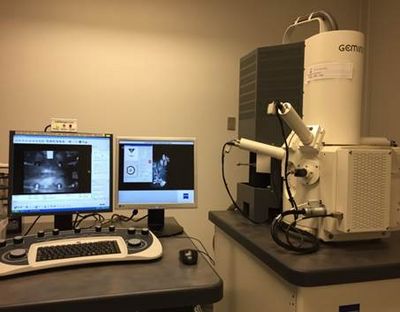Specific Process Knowledge/Characterization/SEM Gemini 1: Difference between revisions
Created page with " '''Feedback to this page''': '''[mailto:labadviser@danchip.dtu.dk?Subject=Feed%20back%20from%20page%20http://labadviser.danchip.dtu.dk/index.php/Specific_Process_Knowledge/Characterization/SEM_Supra_1 click here]''' <!--Checked for updates on 30/7-2018 - ok/jmli --> ''This page is written by DTU Nanolab internal'' 400x400px|right|thumb|The SEM Supra 1 located in basement 346-907.{{photo1}} " |
No edit summary |
||
| Line 1: | Line 1: | ||
'''Feedback to this page''': '''[mailto:labadviser@danchip.dtu.dk?Subject=Feed%20back%20from%20page% | '''Feedback to this page''': '''[mailto:labadviser@danchip.dtu.dk?Subject=Feed%20back%20from%20page%20https://labadviser.nanolab.dtu.dk//index.php?title=Specific_Process_Knowledge/Characterization/SEM_Gemini_1 click here]''' | ||
''This page is written by DTU Nanolab internal'' | ''This page is written by DTU Nanolab internal'' | ||
[[image:LA_SEM_Supra_1.jpg|400x400px|right|thumb|The SEM | [[image:LA_SEM_Supra_1.jpg|400x400px|right|thumb|The SEM Gemini 1 being installed in the cleanroom.{{photo1}} ]] | ||
====DTU Nanolab news August 2023==== | |||
===DTU Nanolab introduces next-generation SEM in the cleanroom=== | |||
Right now, we are installing a new field emission scanning electron microscope (FE-SEM) in the B-section of the cleanroom. It is a state-of-the-art GeminiSEM 560 with the new Gemini 3 column from Carl Zeiss. | |||
The tool is next-generation compared to our present three about 10 years old Supra-40/60 SEM’s (also from Carl Zeiss). We are looking forward to offer our users access to all the new features provided by this tool, a.o.: | |||
<b>Detectors:</b> | |||
* SE2: Chamber mounted secondary electron (SE) detector | |||
* In-lens SE: In-column high resolution SE detector | |||
* In-lens EsB: In-column highly sensitive backscatter electron (BSE) detector for obtaining good material contrast | |||
* aBSD: Retractable column mounted solid state BSE detector with six sectors for detection of energy and angle selective backscattered electrons, i.e. for obtaining both material and topographical contrast | |||
* VPSE: Variable pressure (VP) light detector for SE signal detecting | |||
* aSTEM: Retractable solid state STEM detector with five sectors enabling bright field and both annular and oriented dark-field transmission electron imaging | |||
<b>Dramatically improved performance on insulating samples achieved via two pathways:</b> | |||
* Latest generation column design that takes low kV imaging to the next level | |||
* Sophisticated low vacuum modes for charge compensation: | |||
* Standard variable pressure (VP) | |||
* NanoVP: A retractable differential pumping aperture mounted on the column makes it possible to use the In-lens SE and ESB detectors in VP mode | |||
<b>Other features:</b> | |||
* Installed on an actively damped anti-vibration platform and with magnetic field cancellation system to protect it from external sources of noise | |||
* Sample bias option and dedicated sample holders | |||
* Plasma cleaner for in-situ sample and chamber cleaning | |||
* Sample loading trough a load lock or the chamber door | |||
* Load lock mounted camera for easy sample navigation | |||
* Several new automated features | |||
We will spend the coming weeks on the installation and acceptance tests of the tool and prepare the training protocol. | |||
We hope that you will receive the tool well when we release it, which we expect to do in September. | |||
The image shows a freshly cleaved cross section of a mulilayered thin film of alternating layers of 5 nm TiO2 and 5 nm Al2O3 deposited by ALD. | |||
Revision as of 11:00, 2 August 2023
Feedback to this page: click here
This page is written by DTU Nanolab internal

DTU Nanolab news August 2023
DTU Nanolab introduces next-generation SEM in the cleanroom
Right now, we are installing a new field emission scanning electron microscope (FE-SEM) in the B-section of the cleanroom. It is a state-of-the-art GeminiSEM 560 with the new Gemini 3 column from Carl Zeiss. The tool is next-generation compared to our present three about 10 years old Supra-40/60 SEM’s (also from Carl Zeiss). We are looking forward to offer our users access to all the new features provided by this tool, a.o.:
Detectors:
- SE2: Chamber mounted secondary electron (SE) detector
- In-lens SE: In-column high resolution SE detector
- In-lens EsB: In-column highly sensitive backscatter electron (BSE) detector for obtaining good material contrast
- aBSD: Retractable column mounted solid state BSE detector with six sectors for detection of energy and angle selective backscattered electrons, i.e. for obtaining both material and topographical contrast
- VPSE: Variable pressure (VP) light detector for SE signal detecting
- aSTEM: Retractable solid state STEM detector with five sectors enabling bright field and both annular and oriented dark-field transmission electron imaging
Dramatically improved performance on insulating samples achieved via two pathways:
- Latest generation column design that takes low kV imaging to the next level
- Sophisticated low vacuum modes for charge compensation:
- Standard variable pressure (VP)
- NanoVP: A retractable differential pumping aperture mounted on the column makes it possible to use the In-lens SE and ESB detectors in VP mode
Other features:
- Installed on an actively damped anti-vibration platform and with magnetic field cancellation system to protect it from external sources of noise
- Sample bias option and dedicated sample holders
- Plasma cleaner for in-situ sample and chamber cleaning
- Sample loading trough a load lock or the chamber door
- Load lock mounted camera for easy sample navigation
- Several new automated features
We will spend the coming weeks on the installation and acceptance tests of the tool and prepare the training protocol. We hope that you will receive the tool well when we release it, which we expect to do in September.
The image shows a freshly cleaved cross section of a mulilayered thin film of alternating layers of 5 nm TiO2 and 5 nm Al2O3 deposited by ALD.
